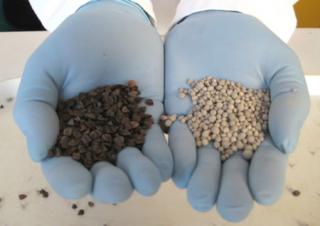Improving phosphorous supply in organic agriculture
Published on 23 November 2010 in Sustainability and Communities

Introduction
Supply and availability of phosphorous (P) is one of the major limiting factors in organic production systems. The demand for home produced organic food currently exceeds that which can be supplied. Phosphorus management must be optimised to meet yield and quality requirements, but the use of water-soluble P fertilisers e.g. triple superphosphate (TSP), is prohibited in organic farming.
Minimally processed phosphate rock (PR) can be used, but it has low solubility under prevailing soil conditions in the UK, which reduce the general agronomic usefulness and potential benefits that any direct application might provide. Being able to improve rates of P dissolution either prior to PR application or in field, through some control of the solubilisation process, would offer widespread potential advantages.
Key Points
Direct application of PR to provided marginal differences to the yield of the majority of crops that immediately followed PR application, although economic analysis indicated that the costs of application were, with the exception of field beans, recoverable.
Longer term benefits of the application of PR to both the soil and crop yields throughout a rotation were not apparent in this study because duration was too short. Any addition benefits, such as reduced nitrate leaching and soil erosion plus weed suppression arising from a green manure were not assessed.
Response of crops to the application of PR varied. Rye and buckwheat both mobilised P rapidly from the applied PR. Whilst rye will be well known to producers, buckwheat has been little cultivated in the UK for the last 50 years. Currently there is limited opportunity to cash crop buckwheat in the UK, but the levels of P the crop quickly took up and mobilised in the soil make it well suited for consideration as a P mobilising green manure.
Addition of PR to compost increased total P, but was shown to reduce the levels of plant available P in the final product. Again the long term fate of the increased total P in these composts once applied to soil under a rotation could not be ascertained within this project.
Case studies, conducted on the farms involved in the project, highlighted that not every farmer can easily establish a composting facility. Inadequate provision of land, machinery and labour at some sites had a marked impact on the quality of the product.
Research Undertaken
Field application experiments involving green manure crops and rotations
Direct application of PR in rotation experiments were conducted at four farms with contrasted climates, soil and management/cropping. Green manures (which included forage rye, forage rape, field beans and buckwheat) were sown directly after autumn application of PR and their influence on P solubility measured directly in soil and through the following two crops. Significant differences in the effectiveness of various green manures and location were apparent. Forage rye plus PR significantly increased grain yields in the following grain crop (~10% compared to forage rye only). A green manure crop of buckwheat showed very clear ability to solubilise PR particularly on soils low in P. Green manures are likely to provide additional benefits such as soil protection, weed suppression and reduced nitrogen (N) leaching.
Pre-application options including the co-composting of PR
Preliminary studies of co-composting PR with organic material were carried out to test the effectiveness of various widely available waste materials. Fermented brassica waste demonstrated particularly promising results and was used as the primary material in subsequent composting trials. Lab based composting experiments were scaled up at both the farms involved in the project and at a commercial composting facility. The result of the application of the resultant composts, with and without PR inclusion, were monitored at each farms on various crops.
Policy Implications
Currently the UK Organic Action Plans (Defra, RERAD) aim to increase the proportion of the organic food market met by indigenous production to 70%, but the use of water-soluble P fertilisers e.g. triple superphosphate (TSP), is prohibited in organic farming (EC Regulations 2092/91 and 1804/99; see Annex 1).
Providing information that helps to establish and maintain the balance between P supply, to sustain production, while minimising losses through diffuse transport pathways has direct relevance in development of sustainable farming systems and assisting in legislative compliance (Water Framework Directive).
Feedback from workshops organised as part of the project highlighted the continuing effort needed in the general management of phosphorus on farmland. Producers expressed a willingness to explore the wider role of green manures as potential opportunities to improve P solubility. Uptake and adoption of some of the rotational and application practises investigated during this project will result in improving P supply in organic systems. The knock on effect of this will be improved UK yields and therefore an increased home-grown market share.
Author
Oliver Knox, SAC and Project Manager of Plink (part of the LINK sustainable programme) Oliver.Knox@sruc.ac.uk
Topics
Sustainability and Communities







